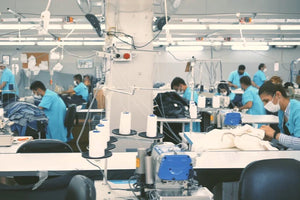Difference between natural and synthetic indigo: environmental impact and production process
Jan 09, 2025
Indigo is a deep blue dye that has been used to color textiles for thousands of years. While indigo used to be obtained exclusively from plants, synthetic production has been established since the late 19th century. In this article, we will examine the differences between natural and synthetic indigo, take a look at their production processes, and consider the environmental impact of both methods.
Natural Indigo
Natural indigo is obtained from plants such as Indigofera tinctoria , Isatis tinctoria (woad) and Polygonum tinctorium . The dye in these plants is present as indican , a colorless glucoside that is converted into the blue dye in a multi-step process:
- Harvesting and fermentation : The leaves of the plants are harvested and fermented in water, breaking down indican into glucose and indoxyl.
- Oxidation : Indoxyl oxidizes upon contact with oxygen to form the blue indigo dye.
- Drying : The dye is collected, dried and processed into powder.
This traditional process is labor-intensive and yields only small amounts of dye. Color qualities can vary depending on the harvest, and processing requires resources such as water, which can pollute the environment if wastewater treatment is inadequate.
Synthetic Indigo
The industrial production of synthetic indigo began in the late 19th century and has since established itself as a reliable and cost-effective method. A common method is the Heumann synthesis , which uses chemical starting materials such as N-phenylglycine . The chemical synthesis makes it possible to produce an indigo that is identical in structure and properties to vegetable indigo.
In our production we use synthetic indigo, which is manufactured according to the strict GOTS (Global Organic Textile Standard) standards . GOTS-certified indigo meets ecological and social criteria that ensure that the environmental impact is kept low. Thanks to GOTS-certified production, energy consumption and emissions in the production process are comparable to the extraction of indigo from plants, but at significantly lower costs .
Benefits of GOTS certified synthetic indigo:
- Environmentally friendly production : The GOTS standard places emphasis on environmentally friendly processes and the minimization of waste and emissions.
- Lower costs : Synthetic production allows for more cost-effective mass production while maintaining a consistent quality that closely mimics natural indigo.
- Structural identity : Synthetic indigo is identical in its chemical structure to vegetable indigo, so the difference is not noticeable in the finished textile.
Environmental compatibility in comparison
Natural indigo requires land cultivation and water resources, which can be environmentally friendly if managed sustainably. Synthetic indigo, on the other hand, is based on industrial processes that are just as resource-saving thanks to modern standards such as GOTS. The GOTS standard requires that production be energy-efficient and environmentally friendly. This results in a comparable environmental impact to that of plant-based indigo, but with the economic advantages of synthetic production.
Conclusion
GOTS-certified production makes synthetic indigo an economical and environmentally friendly alternative to plant-based indigo. The dye is identical in structure to plant-based indigo and offers consistent quality at a lower cost. Our decision to use GOTS-certified synthetic indigo enables us to offer high-quality jeans at fair prices without compromising on environmental standards.




